Want an aliyah? Learn or brush up on the blessings for before and after the Torah readings. Listen here:
Blessings before the Torah reading:
Blessings after the Torah reading:
Read along: Torah blessings with transliteration
Want an aliyah? Learn or brush up on the blessings for before and after the Torah readings. Listen here:
Blessings before the Torah reading:
Blessings after the Torah reading:
Read along: Torah blessings with transliteration
When Shabbat lands on the fifth Friday of the month, Congregaton Beth Israel observes Shabbat at Home. There is no synagogue service; instead, everyone is encouraged to host or attend a Shabbat at Home. Contact the office if you’d like to be connected with a host with extra seats at the table.
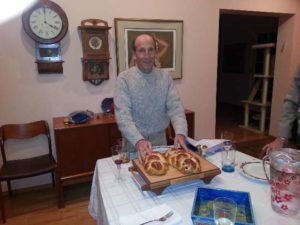
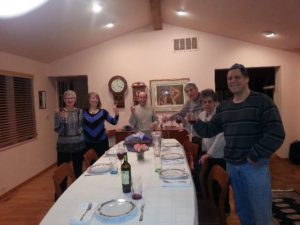

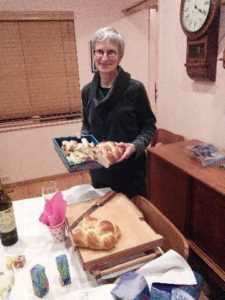
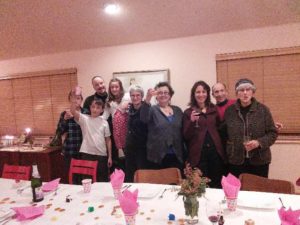
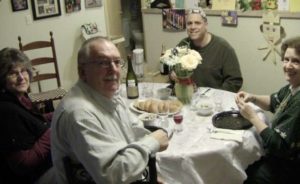
Tishah B’Av means “Ninth of Av” and refers to a Jewish day of fasting and mourning.
Excerpted from The Jewish Home by Daniel B. Syme. URJ Press
Traditionally Tishah B’Av is the darkest of all days, a time set aside for mourning the destruction of both ancient Temples in Jerusalem. As on Yom Kippur, the fast extends until the following sundown. In the synagogue, the Book of lamentations is changed, as are kinot, dirges written during the Middle Ages. Sitting on low stools, a shivah custom, congregants also read sections of the books of Jeremiah and Job, as well as biblical and talmudic passages dealing with the Temples’ destruction.
Reform Judaism has never assigned a central religious role to the ancient Temple. To the early Reformers, mourning the destruction of the Temple in such elaborate fashion did not seem meaningful, especially since Reform has not idealized the rebuilding of the Temple, as has Jewish tradition. For most Reform Jews, then, 586 b.c.e. and 70 c.e. are important dates in Jewish history, but Tishah B’Av has faded in importance as a ritual observance. In order to understand the mournful nature of Tishah B’Av, then, we must enter the traditional mind as we look back into history.
The First Temple in Jerusalem was constructed during the reign of King Solomon (965 b.c.e.–925 b.c.e.). Solomon’s father, King David, had wished to build the Temple, but was not allowed to do so. The Bible relates that God disqualified David because of his many military campaigns. The Temple was to be a holy place, a place of peace. Therefore, only a king who had not shed blood could bring it into being. Thus, Solomon, whose Hebrew name was Shlomo (from shalom, peace), inherited this sacred task.
Solomon built the First Temple with the assistance of King Hiram of Tyre. Hiram sent his Phoenician artists and builders magnificent stone from his nation’s quarries and the beautiful cedars of Lebanon to aid in the task.
The finished Temple was an awesome structure. Situated on a mountain 2/500 feet high, it had courtyard, a sanctuary, and a small room called the Holy of Holie, entered only once a year by the high priest. It was in the Temple that the kohanim (priests) offered the ancient sacrifices on behalf of the people, assisted by the Levites.
In 586 b.c.e., the Babylonian army surrounded Jerusalem. Led by their general, Bebuchadnezzar, they broke into the city and conquered it. Then, on the Ninth of Av, they destroyed the Temple. The Jews were sent into exile, crushed and despondent. According to some scholars, the prophet Jeremiah, grieving for the Temple, composed Psalm 137, in which he wrote: “By the waters of Babylon, we lay down and wept for thee Zion.” A people who had grounded their entire religious system in a priestly Temple structure suddenly had it torn away from them.
Even as he mourned, Jeremiah still had hope. He told the people that they would one day return to Jerusalem and rebuild the Temple. He was correct. Some sixty years later, Persia conquered Babylonia, and the Persian King Cyrus allowed the Jews to return home. They rebuilt the Temple but it was not nearly as magnificent as Solomon’s Temple had been. Still, the Jews rejoiced, for once again they had an opportunity to be led by their priests and to offer sacrifices in their holiest site. It was this rebuilt Temple that King Antiochus defiled in 168 b.c.e., and which the Maccabees reconsecrated three years later. But the Building of the Second Temple was yet to come.
The Second Temple was enhanced and expanded during the first century b.c.e by King Herod, one of the cruelest rulers in Jewish history. Deciding that the rebuilt Temple was not to his liking, Herod decided to expand it. He partially leveled the previous site, then oversaw the construction of a Temple that rivaled that of Solomon’s in grandeur.
Herod had intended to continually add new structures to the Temple grounds, but the work was never completed. In 70 c.e., Roman legions, led by the General Titus, conquered Jerusalem and destroyed the Temple. It was the Ninth of Av. Once again, the Jews were sent into exile, this time to Rome.
Some historians have expressed doubt that the actual destruction of both Temples occurred on the Ninth of Av, but there is no disputing the fact that the day became a symbol of Jewish tragedy. The synagogue ultimately replaced the Temple. [New forms of worship and religious leadership were created.] But Jew continued to hope and pray that the Temple would be restored. The prayer book and songs expressed this yearning, and Tisha B’Av became a vehicle for expressing that deep sorrow.
Celebrating shabbat at home with family and friends creates a warm and wonderful end to your week. Saying or singing blessings over family, candles, wine and challah helps make it sacred. Enjoy this guide from Larchmont Temple, NY. Shabbat Shalom!
1. Invite friends.
2. Ask guests to prepare a Shabbat blessing, song, or story
3. Set a special table for Shabbat dinner.
4. Use a special tablecloth.
5. Arrange fresh flowers in your home.
6. Polish the silver.
7. Pour a nice wine.
8. Bake or buy a challah.
9. Give thanks for the blessings of the week.
10. Light special candles.
11. Read a Shabbat prayer…then read it again.
12. Say blessings over the wine and challah.
13. Sing some nice songs.
14. Listen to the quiet peace of a dinner at home…without phone, TV, or radio.
15. Take a Shabbat walk.
16. Be open to moments of wonder, of soulful encounter.
17. Pause for a moment as Shabbat ends on Saturday night. Sing havdalah!
 Shabbat Anthology Volume II (Book/CD)
Shabbat Anthology Volume II (Book/CD) Invitation to Shabbat, An (with CD) –
Invitation to Shabbat, An (with CD) – 
Edited by Dov Peretz Elkins
$14.95
Share the rich Sabbath experiences of a diverse group of prominent Jewish thinkers. Noted author and anthologist Rabbi Dov Peretz Elkins has mined every vein of Jewish experience to produce a collection of spiritual essays, poetry, and meditations on the transcendent meaning of the seventh day. He culls from a wealth of sources ranging from the traditional to the radical, including among his forty selections works by Sue Levi Elwell, Blu Greenberg, Lawrence Kushner, Michael Lerner, Alicia Suskin Ostriker, W. Gunther Plaut, Gershom G. Scholem, and Elie Wiesel. Sections of the collection explore Shabbat in Classical Texts, Shabbat as the Ultimate Mitzvah, Jews Celebrate Shabbat, and Shabbat in Modern Thought.
“Dov Peretz Elkins is one of the most spiritual people I know. His work continues to be chicken soup for my soul.”
— Jack Canfield, coauthor of Chicken Soup for the Soul

URJ Department of Lifelong Jewish Learning
$2.25
Prepared by the Family Education Committee of the URJ-CCAR Commission on Jewish Education This guide explains each of the four prayers recited on erev Shabbat and suggests alternate ways to incorporate them into various family settings. The blessings are presented in English, in Hebrew, and in transliteration.

Maxine Segal Handelman, Illustrated by Joani Keller Rothenberg
$13.95
Something is not right in the home of Chaim Yonkel and his wife, Esther. Usually their home is filled with the smells of delicious foods, the sounds of laughing children, and happy smiles on everyone’s faces. But this Shabbat finds the family fighting, Shabbat dinner unprepared, and the house a mess.
The Talmud tells the story of two angels, Tov and Rah. According to this legend, these angels follow each person home from synagogue on Shabbat and deliver a blessing. If Shabbat is being honored and the home is filled with Shabbat peace, the angel of good, Tov, gets to deliver the blessing that every Shabbat should be like this one. However, if Shabbat is not being honored, the angel of evil, Rah, gets to deliver the blessing, turning the same words into a curse.
This contemporary version of the talmudic tale, illustrated with breathtaking illustrations by Joani Keller Rothenberg, updates the story for today’s families. The Shabbat Angels will delight the whole family while it teaches the importance of Shabbat shalom, Shabbat peace.

Written and illustrated by Camille Kress
$5.95
This board book for toddlers encourages parents and children to share a rich spiritual and sensory Shabbat experience. Artist and author Camille Kress created this story on cardboard for her young son because heavy pages cannot be torn by little fingers. Her warm watercolors depict Shabbat symbols within the home–candlesticks, challah, and a Kiddush cup–and a family celebrating a peaceful Shabbat evening.
“Simple and engaging.”–Booklist

Written by Michelle Shapiro Abraham,Illustrated by Ann Koffsky
$6.95
From the author of Good Morning, Boker Tov and Good Night, Lilah Tov, Michelle Abraham’s latest book introduces preschoolers to the joy of Shabbat.
In simple, rhyming language, Shabbat Shalom! tells the story of family celebrating Shabbat. . Filled with prayers and beautiful illustrations, Shabbat Shalom! is a wonderful way to teach toddlers about lighting Shabbat candles, reciting the Kiddush, saying the blessing over the challah and more. Abraham’s educational books for preschoolers are proven successes, making learning fun and exciting. Shabbat Shalom! is the perfect compliment to the Morning/Bedtime Rituals books, creating a strong start to leading a Jewish life.
| NOTE: Each holiday begins and ends at sundown on the days listed. | |||||
| Jewish Year | 5772 |
5773 | 5774 | 5775 | 5776 |
| Secular Year | Sep ’11 – Sep ’12 |
Sep ’12 – Sep ’13 |
Sep ’13 – Sep ’14 |
Sep ’14 – Sep ’15 |
Sep ’15 – Sep ’16 |
| S’LICHOT SERVICE | Sep 24 | Sep 8 | Aug 31 | Sep 20 | Sep 5 |
| ROSH HASHANAH |
Sep 28-30 |
Sep 16-18 | Sep 4-6 | Sep 24-26 | Sep 13-15 |
| YOM KIPPUR | Oct 7-8 |
Sep 25-26 |
Sep 13-14 | Oct 3-4 |
Sep 22-23 |
| SUKKOT | Oct 12-19 | Sep 30-Oct 7 | Sep 18-25 | Oct 8-15 | Sep 27-Oct 4 |
| ATZERET – SIMCHAT TORAH |
Oct 19-20 |
Oct 7-8 | Sep 25-26 | Oct 16-17 |
Oct 4-5 |
| CHANUKAH | Dec 20-28 |
Dec 8-16 |
Nov 27-Dec 5 | Dec 16-24 | Dec 6-14 |
| TU BISH’VAT | Feb 7-8 |
Jan 25-26 | Jan 15-16 | Feb 3-4 |
Jan 24-25 |
| PURIM | Mar 7-8 | Feb 23-24 |
Mar 15-16 |
Mar 4-5 | Mar 23-24 |
| PASSOVER | Apr 6-13 |
Mar 25-Apr 1 | Apr 14-21 |
Apr 3-10 |
Apr 22-29 |
| YOM HASHOAH | Apr 18-19 | Apr 6-7 | Apr 26-27 | Apr 15-16 | May 4-5 |
| YOM HAZIKARON |
Apr 24-25 | Apr 14-15 | May 4-5 |
Apr 21-22 |
May 10-11 |
| YOM HAATZMA-UT |
Apr 25-26 |
Apr 15-16 | May 5-6 |
Apr 22-23 |
May 11-12 |
| LAG BA’OMER |
May 9-10 |
Apr 27-28 | May 17-18 | May 6-7 | May 25-26 |
| SHAVUOT | May 26-27 |
May 14-15 | Jun 3-4 | May 23-24 |
Jun 11-12 |
| TISHAH B’AV |
Jul 28-29 |
Jul 15-16 |
Aug 5-6 | Jul 25-26 |
Aug 13-14 |
| NOTE: Each holiday begins and ends at sundown on the days listed. | |||||
*The History and Origins of Passover
Pesach, known as Passover in English, is a major Jewish spring festival, commemorating the Exodus from Egypt over 3,000 years ago.
The ritual observance of this holiday centers around a special home service called the seder (meaning “order”) and a festive meal; the prohibition of chametz (leaven); and the eating of matzah (an unleavened bread). On the eve of the fifteenth day of Nisan in the Hebrew calendar, we read from a book called the hagaddah, meaning “telling,” which contains the order of prayers, rituals, readings and songs for the Pesach seder. The Pesach seder is the only ritual meal in the Jewish calendar year for which such an order is prescribed, hence its name.